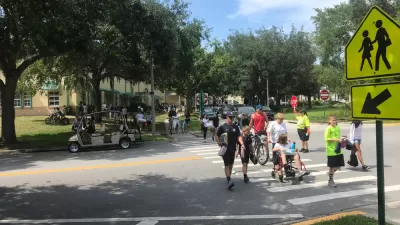"Purely an accident" is how the Los Angeles County Sheriff's Department characterized the one-person, single-vehicle rollover crash that severely injured golfing celebrity Tiger Woods on Feb. 23 while driving on the Palos Verdes Peninsula.

The Los Angeles County Sheriff's Department, like many other law enforcement agencies and many in the media, is unfamiliar with a public safety campaign launched by the National Highway Traffic Safety Administration (NHTSA) over two decades ago to reframe the language used to describe the cause of injuries to over three million Americans and over 35,000 deaths annually.
“This is purely an accident,” said Los Angeles County Sheriff Alex Villanueva at a news conference on Feb. 24 about Tiger Woods' traffic crash on the Palos Verdes Peninsula in the South Bay region of the county, while also acknowledging that "speed was...maybe a factor in this accident.”
Here's how the Los Angeles Times described some of the crash details:
The luxury sport-utility vehicle was moving fast along twisty Hawthorne Boulevard when its driver lost control, plowing into the center divider, smashing the “Welcome to Rolling Hills Estates” sign to bits and slamming into a curb and a tree.
The 2021 Genesis GV80 rolled and rolled. When it finally came to a stop about 30 yards off the road, it was lying on its side, so damaged that its doors could not be opened. There were no skid marks on the street, no sign of braking.
Crashes are not Accidents
Matt Richtel reported for The New York Times in May 2016 (see related link below) on NHTSA's public safety campaign to reframe the language describing motor vehicle crashes. The Transportation Public Health Link (TPH Link) also provides an excellent summary and supportive references for their road safety campaign.
"On August 11, 1997, the National Highway Traffic Safety Administration (NHTSA) made a formal statement that 'Crashes are not Accidents,'" states the beginning of the fourth section titled, "Setting the Record Straight on Terminology: Accident vs. Crash," on the TPH Link injury-prevention webpage.
"Changing the way we think about events, and the words we use to describe them, affects the way we behave," wrote Pamela Anikeeff, a psychologist with the Traffic Safety Programs of NHTSA.
Motor vehicle crashes and injuries are predictable, preventable events. Continued use of the word “accident” promotes the concept that these events are outside of human influence or control...The concept of “accident” works against bringing all the appropriate resources to bear on the enormous problem of motor vehicle collisions. Continuous use of “accident” fosters the idea that the resulting injuries are an unavoidable part of life.
The road or the driver?
This was not Woods' first one-person, single-vehicle crash, meaning it involved only the driver, and it certainly wasn't the first crash on Hollywood Blvd. It's the road, though, that is getting all the attention.
"On Wednesday, L.A. County Supervisor Janice Hahn said she had directed the county Department of Public Works to conduct a safety review of the stretch of road where the accident occurred, which lies in her district," report Richard Winton and Hayley Smith for the Los Angeles Times (source article).
Hawthorne Boulevard, with a speed limit of 45 mph, is one of the main routes out of the peninsula. The combination of the steep grade, curves and wide lanes often leads to accidents. Residents called it a “dangerous stretch of road” and said there were collisions there all the time.
Since January 2020, there have been 13 accidents, including four with injuries, on the stretch of road where Woods crashed, Villanueva said.
In a follow-up piece on Feb. 25, Winton and Smith note that "[d]rivers were found at fault in all but two of the 13 crashes, the records showed."
Justin King, a personal injury attorney based in the Inland Empire of California, told the Associated Press that if the road could be proven to be unsafe, the municipalities may be held liable. The crash occurred between Rancho Palos Verdes and Rolling Hills Estates.
Joe Giacalone, a retired NYPD Detective Sergeant and a professor at the John Jay College of Criminal Justice told the same AP reporters, Doug Ferguson and Stefanie Dazio, that it was "premature" to call the crash an accident without first conducting blood tests. Ferguson and Dazio note that in 2017, Woods was arrested on a DUI charge and "pleaded guilty to a reduced charge of reckless driving."
From a road safety perspective, unless the crash was caused by an act of God, i.e., a natural event outside of human control, it's never okay to call a motor vehicle crash an accident.
Streetsblog California editor Melanie Curry provides additional analysis of the sheriff's characterization of the Tiger Woods' crash in her post, "Was That an Accident?"
Related in Planetizen:
-
The Critical Importance of Bicycle Infrastructure to Public Health, November 15, 2016
-
Does it Matter if We Call Crashes 'Accidents'? August 25, 2015
FULL STORY: Tiger Woods accident sparks new drive to improve safety on road known for dangers

Study: Maui’s Plan to Convert Vacation Rentals to Long-Term Housing Could Cause Nearly $1 Billion Economic Loss
The plan would reduce visitor accommodation by 25,% resulting in 1,900 jobs lost.

North Texas Transit Leaders Tout Benefits of TOD for Growing Region
At a summit focused on transit-oriented development, policymakers discussed how North Texas’ expanded light rail system can serve as a tool for economic growth.

Why Should We Subsidize Public Transportation?
Many public transit agencies face financial stress due to rising costs, declining fare revenue, and declining subsidies. Transit advocates must provide a strong business case for increasing public transit funding.

How to Make US Trains Faster
Changes to boarding platforms and a switch to electric trains could improve U.S. passenger rail service without the added cost of high-speed rail.

Columbia’s Revitalized ‘Loop’ Is a Hub for Local Entrepreneurs
A focus on small businesses is helping a commercial corridor in Columbia, Missouri thrive.

Invasive Insect Threatens Minnesota’s Ash Forests
The Emerald Ash Borer is a rapidly spreading invasive pest threatening Minnesota’s ash trees, and homeowners are encouraged to plant diverse replacement species, avoid moving ash firewood, and monitor for signs of infestation.
Urban Design for Planners 1: Software Tools
This six-course series explores essential urban design concepts using open source software and equips planners with the tools they need to participate fully in the urban design process.
Planning for Universal Design
Learn the tools for implementing Universal Design in planning regulations.
Ascent Environmental
Borough of Carlisle
Institute for Housing and Urban Development Studies (IHS)
City of Grandview
Harvard GSD Executive Education
Toledo-Lucas County Plan Commissions
Salt Lake City
NYU Wagner Graduate School of Public Service





























